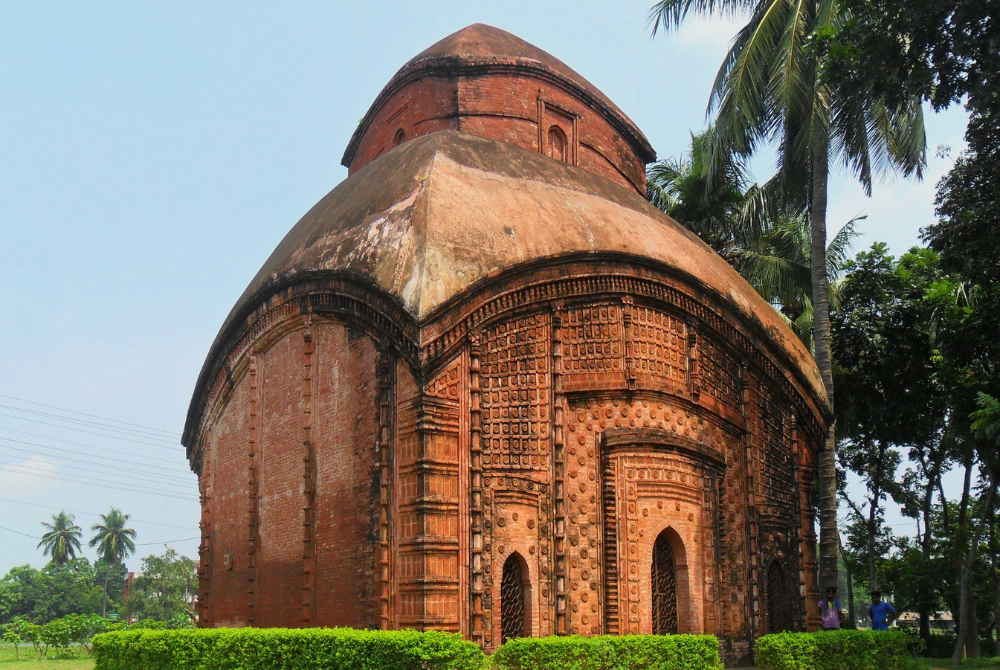Chanchra Shiva Temple: A Marvel of Architectural Heritage in Jessore
Emplaced just four kilometers away from Chanchra Union Parishad in Jessore district, the Chanchra Shiva Temple stands as a testament to Bengal’s unique architectural heritage. This grand temple, built in the distinctive ‘At-Chala’ style, showcases the rich craftsmanship that defines Bengal’s temple architecture, where a smaller ‘Chau-Chala’ roof sits atop the square or rectangular sanctum sanctorum. lets unravel the fascinating history and intricate details of the Chanchra Shiva Temple.
A Glimpse into the Past
Royal Origins
Raja Nilakantha Ray was the ninth male of the Chanchra dynasty. Raja Manohar Roy, the founder of Chanchra Zamindari, was the great-grandfather of Neelkanth Roy. Neelkanth Roy’s daughter’s name is Abhaya King Neelkanth gave this city of Jessore to his daughter after she was widowed at a young age. And Abhaynagar named this city after his daughter.
According to some, Abhaya wanted to spend the rest of her life in worship as there was no rule of second marriage in Hinduism at that time. 11 Shiva temples were established between 1745 and 1764 at the request of Nilakantha’s daughter. That is known as Eleven Shiva Temple.,
in reference to Satishchandra Mitra‘s book titled History of Jessore-Khulna, the Marathas attacked Burdwan under the leadership of a great general named Bhaskar Pandit during the reign of Raja Nilakantha. This attack is known as class riot. Due to the origin of Bargi, the entire West Bengal was in a bad state. As a result the Rajyas of West Bengal came east and started seeking shelter. At the same time King Neelkanth was also seeking shelter for them. The king asked his dewan Hariram Mitra to build a palatial palace on the banks of the river Bhairava. Hariram also had no concrete house. The king himself asked to build a house for Hariram as well. Hariram’s house was in Baghutia. So Hariram’s own house was built at Abhaynagar near Baghutia and the royal palace at Dhulgram a short distance from here.
At that time, the temple was the main beauty of the palace and the idols of the gods and goddesses of the temple were the main wealth. So to enhance the beauty of the Rajbari, twelve temples were built on the banks of the river Bhairav near the Rajbari of Dhulgram. And eleven Siva temples were built at Abhaynagar a little further from the river. The house at Abhaynagar is the house of the Dewan and the number of temples is one less. Dhulgram’s house was surrounded by paved and strong walls. But the house at Abhaynagar was of crude masonry, and the walls were not very strong. Both houses are enclosed; Bhairava river on one side and Garkhai on other three sides. King Nilakantha, coming to inspect the house at the end of its construction, said that the temporary abode of kings need not be very solid. Hariram may live permanently in Dhulgram’s house. Abhaynagar house is enough for kings.

Architectural Splendor: Divine Craftsmanship
The historic Shiv Mandir in Chanchra village, part of the Jessore district’s Sadar upazila, is a stunning example of beautiful architecture. Chanchra Shiva Temple stands as a testament to Bengal’s unique temple architecture, celebrated for its intricate craftsmanship. The temple’s walls showcase intricate carvings and designs, a testament to the skills of the artisans of that era. Visitors will be captivated by the temple’s grandeur and the stories etched into its walls.
This temple, bears witness of a remarkable history spanning 322 years, dating back to 1696 AD when it was commissioned by King Manohar Roy. It is known from the inscription found on the temple’s body, which dates back to 1658 and indicates the temple’s historical significance.
Its historical significance is documented in Satishchandra Mitra’s book, “History of Jessore-Khulna,” published in Calcutta in 1914. In the chapter titled ‘Chanchra Dynasty,’ the grand ceremony held in the palace of Chanchra during Durgotsavadi festivities is described. It was during this time that King Manohar Roy constructed this grand Shiva temple alongside a vast excavated water reservoir known as “Shiva Sagar.”

Preservation and Recognition: A Protected Heritage
Chanchra Shiva Temple is recognized and protected by the Department of Archaeology in Bangladesh, in accordance with UNESCO‘s guidelines for the preservation of cultural heritage. In 2008, the temple underwent significant restoration efforts to ensure its continued existence and glory.
The Chanchra Shiva Temple is not just a temple; it’s a living testament to Bengal’s rich cultural heritage and architectural prowess. As you explore its intricate carvings and immerse yourself in its history, you’ll be transported to a bygone era of grandeur and devotion. A visit to this remarkable temple is a journey through time, offering a glimpse into the heart of Bengal’s artistic and spiritual legacy. Don’t miss the opportunity to witness this architectural marvel in the heart of Jessore.

